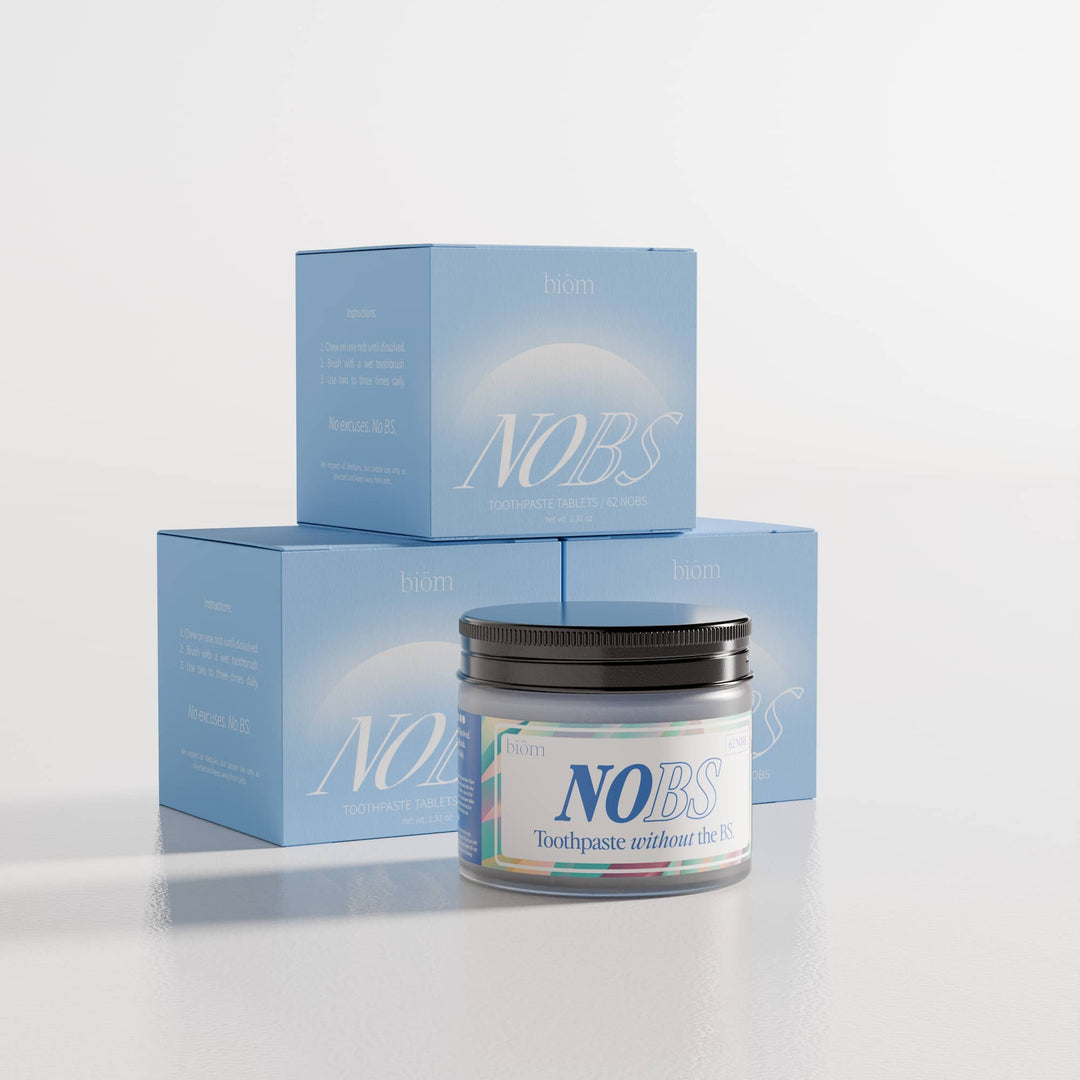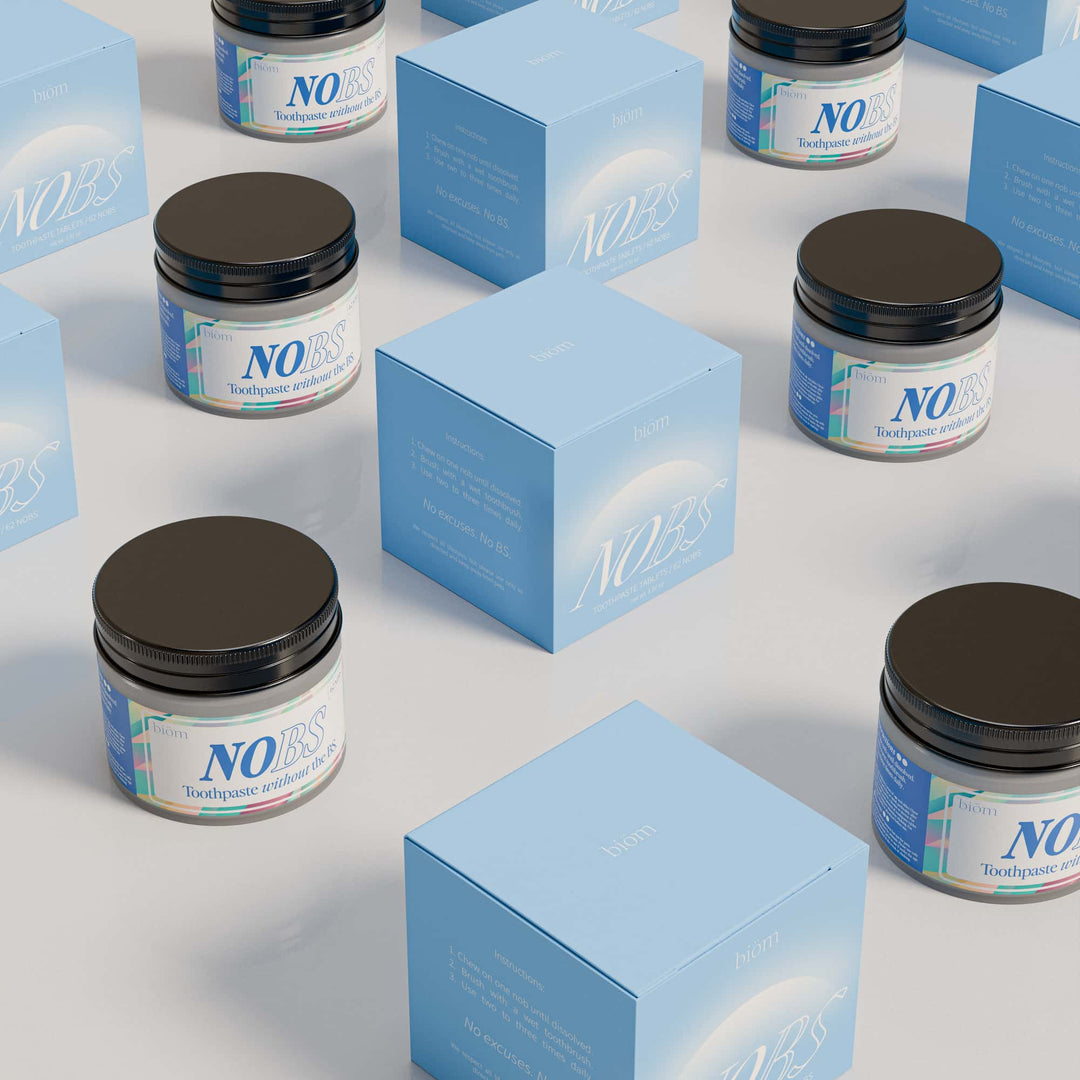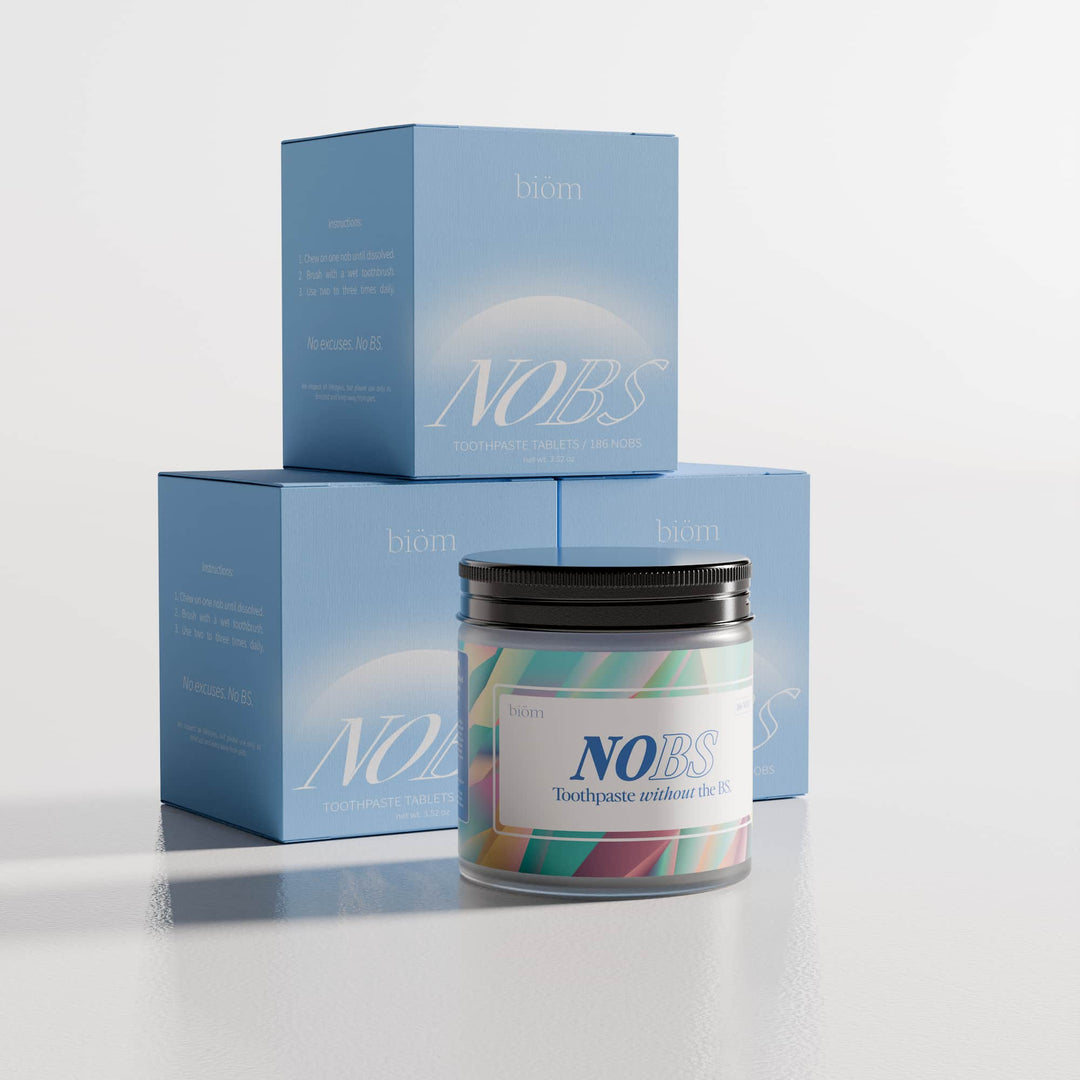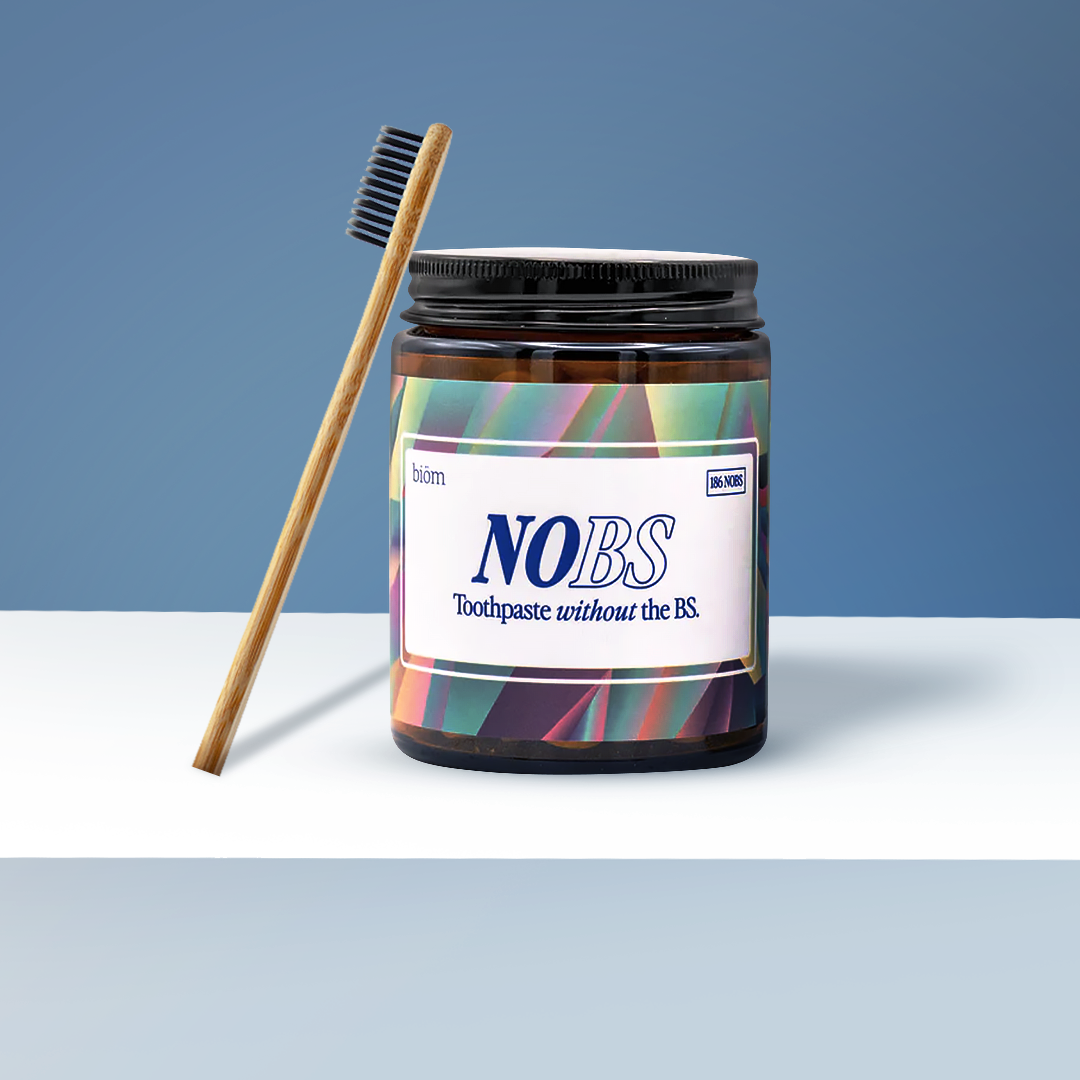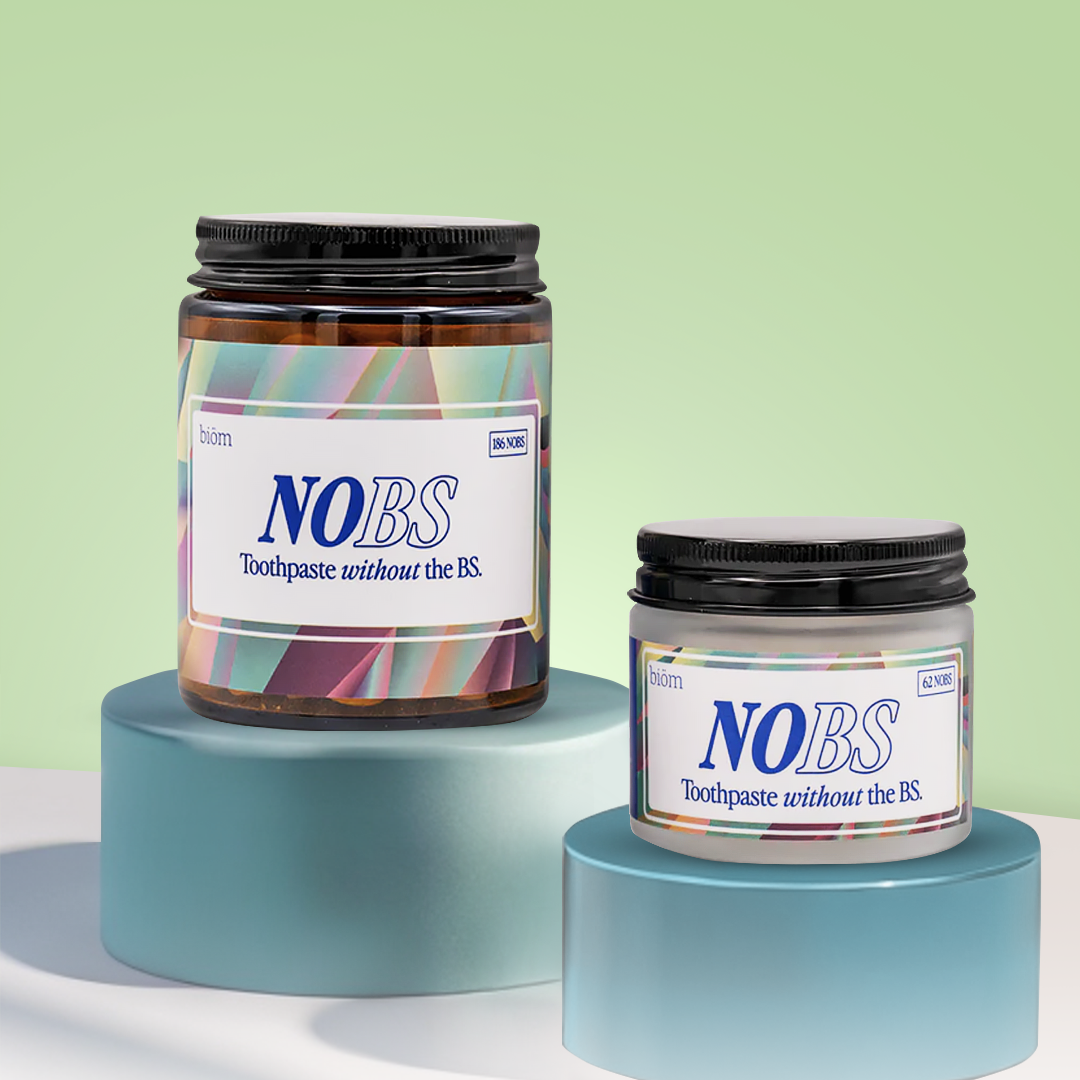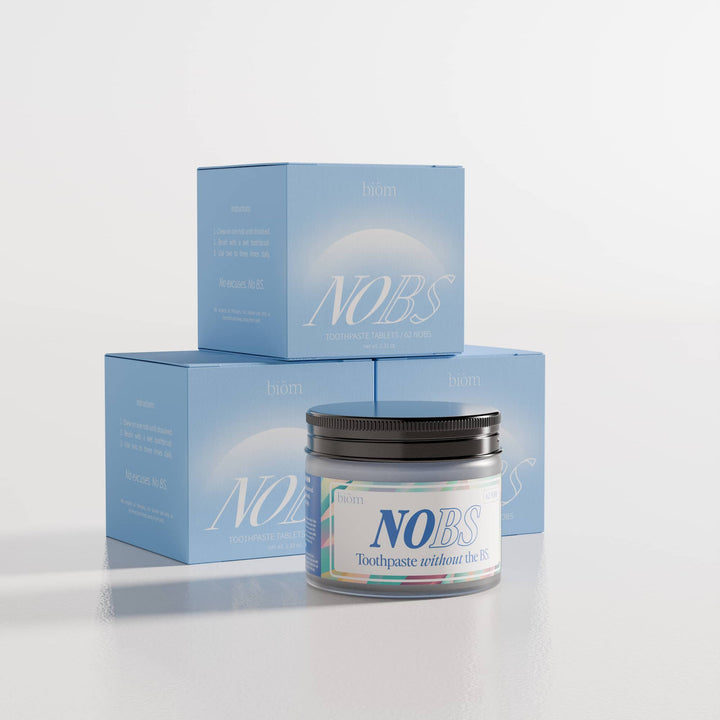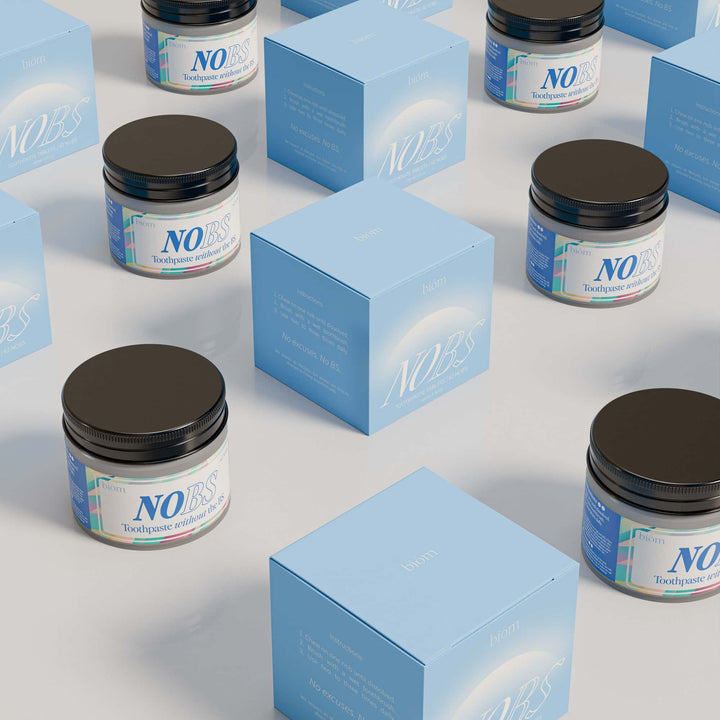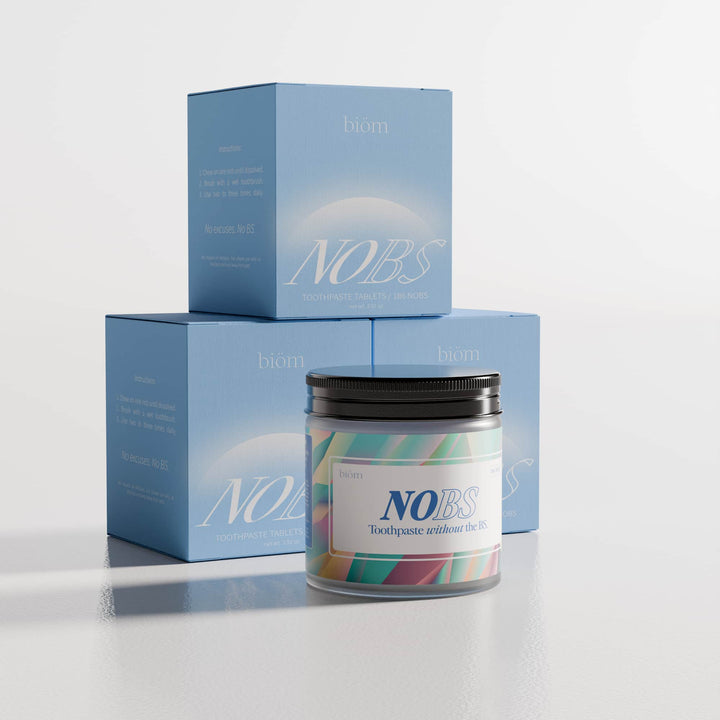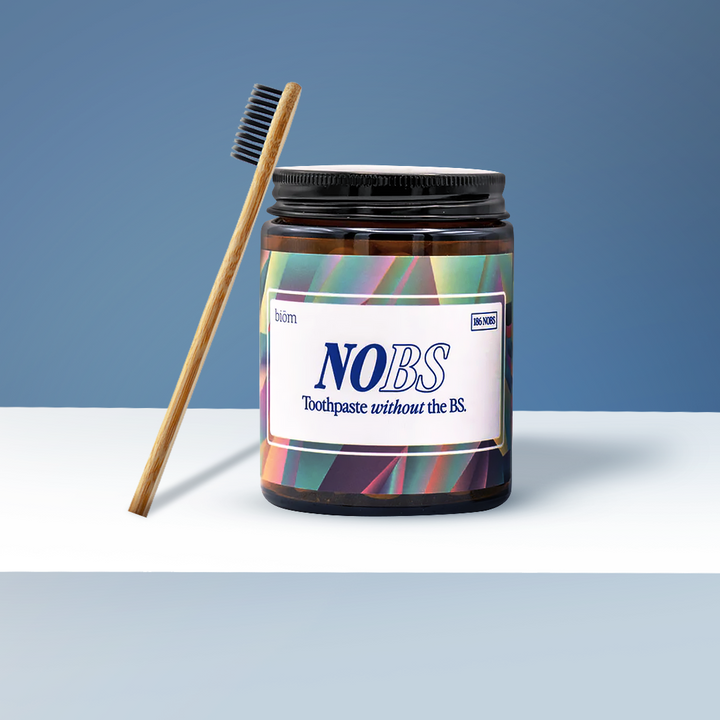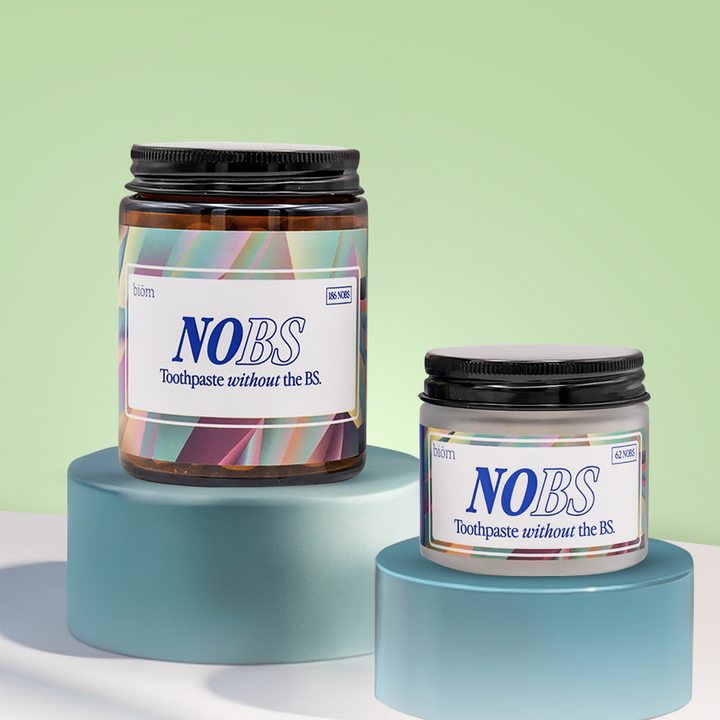Is Fluoride in Toothpaste Good or Bad?
Fluoride in toothpaste is generally considered good for dental health when used appropriately. Fluoride strengthens tooth enamel, making our teeth more resistant to acid attacks from plaque bacteria and sugars in the mouth.
This can help prevent tooth decay and cavities, leading to improved oral health overall. Additionally, fluoride has been shown to promote remineralization, the process of replacing lost minerals in tooth enamel, which can reverse early stages of tooth decay.
However, excessive fluoride intake, particularly during early childhood when teeth are still developing, can lead to dental fluorosis, a condition characterized by white or brown spots on the teeth, and skeletal fluorosis. Therefore, many people prefer to use nano hydroxyapatite, a safe and effective alternative to fluoride.
In this article, I'll explain everything you need to know about whether fluoride in toothpaste is good or bad.
First, what is fluoride?

Fluoride is a naturally occurring mineral found in soil, water, and certain foods. In oral care products, fluoride is added in the form of sodium fluoride, sodium monofluorophosphate, or stannous fluoride to help prevent tooth decay and cavities.
Fluoride toothpaste is a type of toothpaste that contains fluoride as its active ingredient. It works by incorporating fluoride ions into your enamel, making it stronger and more resistant to acid attacks from plaque-causing bacteria.
This process, known as remineralization, strengthens the enamel and reduces the risk of tooth decay.
Additionally, fluoride toothpaste may also inhibit the growth of bacteria in the mouth and reduce the production of acids that can erode tooth enamel, further contributing to cavity prevention.
Regularly using remineralizing toothpaste with fluoride or nano hydroxyapatite alongside expandable floss, tongue scraping, and using alkaline mouthwash can help support overall oral health and reduce your risk of developing tooth decay.
Why is fluoride in our toothpaste?
Fluoride has long been regarded as the gold standard in toothpaste due to its proven ability to prevent cavities and promote oral health.
Initially discovered for its cavity-preventing properties, fluoride was widely adopted in oral care products and public health initiatives, including water fluoridation programs. The implementation of fluoride in water supplies significantly reduced cavity rates and improved dental health outcomes across populations.
That said, it's not without its pros and cons.
Advancements in technology and scientific understanding have led to the development of alternatives like nano hydroxyapatite, which offer comparable remineralization potential without some of the potential side effects associated with fluoride.
While fluoride remains effective in strengthening enamel and inhibiting bacterial growth, concerns have arisen regarding its long-term safety and potential adverse effects, such as skeletal fluorosis and cognitive impacts in children.
As research continues to evolve, there is growing recognition of the need to explore alternative approaches to dental care that balance efficacy with safety.
Nano hydroxyapatite, a more effective derivative of hydroxyapatite, has emerged as a better alternative to fluoride toothpaste due to its safety profile.
How does fluoride work on teeth?

Fluoride toothpastes work primarily by remineralizing and strengthening tooth enamel, which is the protective outer layer of our teeth.
When you brush with fluoride toothpaste, fluoride ions can be absorbed into the enamel, forming a compound known as fluorapatite. This compound is more resistant to acid attacks from bacteria in plaque and reduces your chances of enamel demineralization and developing tooth decay.
Additionally, fluoride can repair early stages of tooth decay and control dental caries by promoting remineralization, where minerals are deposited back into areas of weakened enamel, restoring its strength.
Furthermore, fluoride can inhibit the growth of bacteria that cause dental plaque and reduce their ability to produce acids that can erode tooth enamel. By disrupting the bacteria's metabolic processes, fluoride supports a balanced oral environment and reduces your risk of developing cavities.
That said, it's worth noting that you cannot remineralize a cavity once it has already formed.
Overall, fluoride works through multiple mechanisms, including:
-
strengthening enamel
-
promoting remineralization
-
inhibiting bacterial growth
-
and reducing acid production,
making it an effective tool in preventive dental care.
Benefits of Fluoride Toothpaste

Fluoride toothpaste offers several benefits for our oral health. First, fluoride helps strengthen tooth enamel, making it more resistant to acid attacks from bacteria in the mouth, thus reducing your risk of tooth decay and cavities.
Additionally, fluoride can remineralize weakened enamel, potentially reversing the early stages of tooth decay and preventing further damage. Further, fluoride toothpaste can inhibit the growth of harmful bacteria in our mouths, reducing plaque formation and the risk of gum disease.
Let's walk through some of the key benefits of fluoride toothpaste now.
Remineralization
Remineralization is a crucial process in maintaining strong and healthy teeth. When tooth enamel becomes demineralized due to acid attacks from bacteria in the mouth or acidic foods and beverages, it loses essential minerals like calcium and phosphate.
Remineralization involves the replenishment of these lost minerals, effectively strengthening the enamel and reversing the early stages of tooth decay. Two of the most popular remineralizing agents in toothpaste are nano hydroxyapatite and fluoride.
When you brush, fluoride toothpaste facilitates remineralization by enhancing the absorption of calcium and phosphate ions into the enamel surface. This strengthens the enamel, making it more resistant to acid attacks and preventing further decay.
Additionally, fluoride can protect your teeth by forming a protective layer over the enamel, shielding it from harmful bacteria and acidic substances in your mouth. By promoting remineralization, fluoride toothpaste helps maintain the integrity of the tooth structure, reducing your risk of cavities and preserving overall oral health.
Reversing Tooth Decay
Like nano hydroxyapatite, fluoride prevents tooth decay and can even reverse it thanks to enamel remineralization.
When our teeth are exposed to acids from bacteria in the mouth or acidic foods and beverages, they lose essential minerals like calcium and phosphate, leading to demineralization and the early stages of tooth decay. Fluoride toothpaste contains fluoride ions, which strengthen and remineralize our enamel by attracting calcium and phosphate ions back into the tooth structure.
This process effectively reverses the damage caused by acid attacks, restoring the minerals lost during demineralization and making the enamel stronger and more resistant to decay.
Preventing Bacteria Growth
When bacteria in our mouths feed on sugars from food and beverages, they produce acids that can attack the enamel of our teeth, leading to decay and cavities. Fluoride toothpaste inhibits the growth of these harmful bacteria by creating an environment that is less favorable for their proliferation.
By reducing the number of bacteria in the mouth, fluoride toothpaste helps to minimize the production of acids and the formation of plaque, thereby lowering the risk of tooth decay and gum disease.
So, when you use fluoride toothpaste or nano hydroxyapatite toothpaste regularly, you're not only cleaning your teeth but also actively protecting them against harmful bacteria.
Reducing Plaque Formation

Reducing plaque formation is a significant benefit of fluoride toothpaste that directly contributes to better oral health.
Plaque is a sticky film of bacteria that forms on the surface of our teeth throughout the day, particularly after eating or drinking. If left unchecked, plaque can lead to tooth decay, gum disease, and other oral health issues.
Fluoride toothpaste inhibits the formation of plaque by disrupting the ability of bacteria to adhere to the tooth surface. By reducing plaque buildup, fluoride toothpaste helps to prevent the development of cavities and keeps your teeth and gums healthy.
Risks of Fluoride Toothpaste
Fluoride, when used in appropriate amounts, is generally safe and effective for strengthening teeth and promoting overall oral health. However, too much fluoride intake can lead to potential side effects.
Dental Fluorosis
Dental fluorosis is a condition that affects the appearance of tooth enamel, typically occurring during the early stages of tooth development in childhood.
It manifests as white streaks or spots, brown discoloration, or pitting on the tooth surface. Dental fluorosis occurs when children ingest too much fluoride during tooth formation, often from swallowing fluoride toothpaste or consuming fluoridated water in excess.
While mild forms of dental fluorosis may be barely noticeable, severe cases can lead to significant aesthetic concerns and may require cosmetic dental treatment to improve the appearance of affected teeth.
Skeletal Fluorosis
Skeletal fluorosis is a bone disorder caused by long-term exposure to high levels of fluoride, typically from drinking water with naturally occurring fluoride concentrations above recommended levels.
In skeletal fluorosis, fluoride accumulates in the bones, leading to changes in bone density and structure. Symptoms of skeletal fluorosis may include joint pain, stiffness, and skeletal deformities.
While skeletal fluorosis is rare in areas with controlled fluoride levels, it remains a concern in regions where natural fluoride levels are high or in populations with excessive fluoride exposure.
Fluoride Toxicity
Fluoride toxicity occurs when individuals ingest large amounts of fluoride, either accidentally or intentionally. This can happen through the ingestion of fluoride-containing products such as toothpaste or mouthwash, especially by young children who may swallow these products instead of spitting them out.
Symptoms of fluoride toxicity may include nausea, vomiting, abdominal pain, diarrhea, and in severe cases, convulsions and cardiac arrhythmias.
While acute fluoride toxicity is rare, it can occur in cases of accidental ingestion of concentrated fluoride products or intentional misuse of fluoride supplements.
Pros and Cons of Fluoride Toothpaste
In the debate over fluoride in toothpaste, it's essential to consider both its benefits and drawbacks to make an informed decision.
Here's a balanced look at the pros and cons of fluoride use:
Pros of Fluoride:
- Cavity Prevention: Fluoride is proven to be effective in preventing cavities by remineralizing tooth enamel and reversing early signs of tooth decay.
- Enamel Strengthening: It helps in strengthening tooth enamel, making it more resistant to acid attacks from plaque bacteria and sugars in the mouth.
- Widespread Benefits: As mentioned earlier, fluoridation of community water supplies has been a successful public health strategy for reducing the prevalence of dental caries in populations.
Cons of Fluoride:
- Risk of Dental Fluorosis: Excessive fluoride, especially during the early years of tooth development, can lead to dental fluorosis, characterized by changes in the appearance of tooth enamel.
- Potential Toxicity: In high doses, fluoride can be toxic, leading to serious health issues. This is a particular concern when fluoride is ingested in large amounts.
- Individual Sensitivity: Some individuals may have a lower tolerance or sensitivity to fluoride, necessitating the need for alternative dental care options.
While fluoride has its benefits, these concerns highlight the importance of using it cautiously, especially in children.
This is where fluoride-free alternatives like nano hydroxyapatite toothpaste tablets can offer effective dental care without the associated risks of fluoride.
Is fluoride free toothpaste better?
Yes, fluoride-free toothpaste can be better, especially if it contains nano hydroxyapatite.
Scientific research shows that nano hydroxyapatite helps remineralize enamel and can be just as effective as fluoride in preventing cavities.
Unlike fluoride, nano hydroxyapatite is non-toxic and biocompatible, making it a safer choice for some people, such as those with fluoride sensitivities.
Moreover, it has a non-abrasive nature, so it won't damage tooth surfaces over time. For individuals seeking an eco-friendly or fluoride-free option, toothpaste with nano hydroxyapatite can provide excellent oral care benefits.
Therefore fluoride-free toothpaste with this ingredient can be a great alternative to traditional fluoride-based options.
Is fluoride safe?

Yes, fluoride is generally considered safe when used appropriately and in recommended amounts for certain populations. It has been extensively studied and recognized by leading health organizations, including the American Dental Association (ADA) and the World Health Organization (WHO), for its effectiveness in preventing tooth decay and promoting oral health.
Fluoride occurs naturally in water sources and is also added to dental products like toothpaste and mouthwash to help strengthen tooth enamel and reduce the risk of cavities. However, excessive fluoride intake can lead to dental fluorosis, a condition characterized by white spots or streaks on the teeth, or skeletal fluorosis.
Additionally, research suggests that fluoride intake is associated with lower IQ scores in children.
While fluoride is commonly used in toothpaste for its ability to prevent tooth decay and strengthen enamel, you may prefer fluoride-free alternatives due to concerns regarding potential adverse effects associated with fluoride exposure. For example, those with fluoride sensitivities or allergies may experience discomfort or irritation when using fluoride-containing toothpaste.
Further, parents and pregnant women may opt for fluoride-free toothpaste formulations to maintain good oral health without the potential drawbacks associated with fluoride exposure. Thankfully, fluoride-free toothpaste with nano hydroxyapatite exists as a safe and effective alternative to fluoridated toothpastes.
Nano hydroxapatite is an inorganic chemical compound that closely mimics that natural composition of our teeth and bones. Not only are hydroxyapatite-based toothpastes safe, but nano hydroxyapatite is equally as effective as fluoride at remineralization and improving oral hygiene.
Is fluoride toothpaste safe for children?
Yes, fluoride toothpaste is generally considered safe for children when used appropriately and under adult supervision.
The American Academy of Pediatrics (AAP) recommends using fluoride toothpaste for children as soon as their first tooth erupts. However, the amount of toothpaste used should be minimal, no more than a smear or rice-sized amount for children under three years old, and a pea-sized amount for children aged three to six years.
This helps minimize the risk of swallowing too much fluoride, which can lead to dental fluorosis if ingested in excess during the tooth development stage.
Unfortunately, research suggests there are some risks involved with fluoride toothpaste for kids, however. For example, one study reported, "the accidental swallowing of fluoridated toothpaste in children may be 2–3 times the safe limit, suggesting that use of fluoridated toothpaste may be a risk factor for dental fluorosis".
During Gestation

Despite the belief that fluoride is safe for everyone, research suggests otherwise. For example, a Canadian study reported that higher fluoride exposure in pregnant women was associated with lower IQ scores in young children. Further, the same research paper cites multiple studies from 2019 - 2022 which suggested associations between fluoride exposure in pregnancy with adverse neurodevelopmental effects in offspring
Babies
Because fluoride is a topical treatment, experts suggest that fluoride toothpaste shouldn't be used on children before their teeth have erupted. Further, once their teeth have erupted, the amount of fluoride toothpaste should be limited to prevent side effects from accidental ingestion.
Toddlers
Given toddlers have developed teeth, using toothpaste twice per day is essential to keep them strong and healthy. However, one paper states, "Elevated fluoride intake during early development can result in IQ deficits that may be considerable. Recognition of neurotoxic risks is necessary when determining the safety of fluoride-contaminated drinking water and fluoride uses for preventive dentistry purposes."
Children
While fluoride is considered the gold standard in dental caries prevention by the American dental Association, research on the safety of using for children is mixed. One paper suggests that while fluoride toothpaste was effective for fighting dental cavities for children younger than 6, ingesting a pea-sized amount or more could lead to mild fluorosis. For these reasons, many people choose to avoid fluoride in toothpaste.
GUIDELINES FOR SAFE FLUORIDE USE
For those of you who choose to use fluoride toothpaste, especially for your children, it's crucial to do so safely to minimize any potential risks.
Here are some guidelines for safe fluoride use:
-
Appropriate Amount: For children under three years, use only a smear (the size of a grain of rice) of kids toothpaste. Children aged three to six should use no more than a pea-sized amount.
-
Supervised Brushing: Always supervise children while brushing to ensure they use the correct amount of toothpaste and avoid swallowing it.
-
Spitting Out Toothpaste: Teach children to spit out toothpaste after brushing and avoid rinsing with large amounts of water, as this can help minimize ingestion of fluoride.
-
Regular Dental Check-ups: Consult with your dentist about the appropriate use of fluoride toothpaste for your family, especially if you have concerns about fluorosis or other fluoride-related issues.
-
Understanding Fluoride Levels: Be aware of the fluoride levels in your drinking water and consider this when choosing dental care products.
By following these guidelines, you can help ensure that fluoride is used effectively and safely, particularly in protecting children's developing teeth.
Finally, remember that generally, kids should not use adult toothpaste. For best results, stick to kids hydroxyapatite toothpaste instead.
Are there any alternatives for fluoride toothpaste?
A safer alternative to fluoride is nano hydroxyapatite thanks to its biomimetic nature and natural enamel strengthening properties. Not only is nano hydroxyapatite safe for adults to use, it is even safe to be swallowed by children.
In fact, one study found, "swallowed HA particles are immediately dissolved in the acid environment of the stomach and do not pose any safety concern." Further, research states that there is no literature reporting any systemic or adverse effects of hydroxyapatite containing toothpastes.
Nano hydroxyapatite particles do not induce toxicity the way overconsumption of fluoride can. This is particularly important for certain populations such as:
-
pregnant women
-
children
-
people prone to tooth decay and cavities
-
and people who live in environments with high fluoride concentrations in the water.
That's why many people are turning to nano hydroxyapatite toothpaste as a safe, non toxic toothpaste alternative to fluoride.
Nano Hydroxyapatite vs Fluoride Toothpaste
Dental professionals use fluoride and hydroxyapatite together or individually to control dental caries and for other regenerative dentistry practices.
Both nano hydroxyapatite and fluoride toothpastes are effective for:
-
Fighting tooth decay
-
Remineralizing initial caries lesions
-
Preventing dental caries
-
Soothing hypersensitivity
However, they work differently and have different implications for your holistic health.
Mechanism
While fluoride toothpastes work by depositing fluoride ions into your enamel, fluoride free toothpaste with hydroxyapatite works by depositing naturally beneficial materials like calcium and phosphate ions into your enamel.
Since your enamel is already made of calcium and phosphate, among other materials, synthetic hydroxyapatite reinforces the existing tooth structure.
Efficacy
Nano hydroxyapatite toothpastes are equally as effective as fluoride toothpaste.
Studies show there are no significant difference between the efficacy of nano hydroxyapatite toothpaste and fluoride toothpastes to remineralize initial enamel fissures.
Safety
Since nano hydroxyapatite is a naturally occurring material that your body already makes, there are no safety or toxicity concerns.
On the other hand, fluoride is a controversial ingredient in dentistry for its role in negatively affecting fetal brain development and causing dental fluorosis.
For these reasons, many people feel nano hydroxyapatite is better than fluoride.
Affordability
Nano hydroxyapatite is a more expensive ingredient than fluoride. Thus, nano hydroxyapatite toothpastes tend to be more expensive than fluoridated toothpastes, although not always.
Availability
Fluoride toothpastes are more widely available and can be found at any grocery store, drug store, or online. Hydroxyapatite toothpaste brands are less widely available and more likely to be found online than in retail stores.
What other ingredients are in my toothpaste?
When considering toothpaste ingredients, it's helpful to look for the following categories:
-
Remineralizing Agents: Ingredients hydroxyapatite or nano hydroxyapatite can aid in remineralizing weakened enamel, repairing microscopic imperfections, and strengthening teeth against decay.
-
Abrasive Ingredients: Mild abrasives like hydrated silica, calcium carbonate, or baking soda can assist in removing surface stains and plaque buildup without damaging the enamel.
-
Antimicrobial Agents: Compounds such as zinc citrate can help inhibit the growth of harmful bacteria in the mouth, reducing plaque formation and the risk of gum irritation.
Let's explore some of these key ingredients.
Nano Hydroxyapatite
Nano hydroxyapatite (nHA) is a derivative of hydroxyapatite, a naturally occurring mineral that constitutes the main inorganic component of human teeth and bones.
Nano hydroxyapatite is frequently used as a remineralizing agent in zero fluoride toothpaste. When tooth enamel becomes demineralized due to acid erosion from plaque acids or dietary acids, nano hydroxyapatite can help restore minerals like calcium and phosphate to the enamel surface, effectively remineralizing and strengthening the teeth.
Additionally, nano hydroxyapatite can form a protective layer over the enamel, shielding it from further acid attacks and reversing tooth decay. In comparing nano hydroxyapatite vs hydroxyapatite, nano hydroxyapatite toothpastes tend to be more effective at remineralization and teeth whitening due to the smaller particle size.
It offers a natural alternative to fluoride toothpaste while providing similar benefits in terms of enamel remineralization and cavity prevention. Its biocompatible nature and minimal side effects make it a popular choice among those with sensitivities to fluoride or those looking for safer alternatives in oral care.
Xylitol
Xylitol, a sugar alcohol derived from natural sources like fruits and vegetables, is a near-magical ingredient in oral care. Renowned for its cavity-fighting properties, xylitol effectively disrupts the growth of harmful bacteria, particularly Streptococcus mutans, responsible for dental plaque formation and decay. By impeding bacterial growth, xylitol helps stop the progression of cavities and promotes overall oral health.
Moreover, xylitol toothpaste facilitates the remineralization process by enhancing the absorption of essential minerals like calcium and phosphate into tooth enamel. This fortifies the enamel structure, making teeth more resilient to acid attacks and enamel erosion, thus reducing the likelihood of cavities.
In addition to its anti-cavity prowess, xylitol plays a pivotal role in maintaining a balanced oral environment by curbing acid production and stimulating saliva flow. Its natural sweet taste not only enhances the palatability of toothpaste but also encourages saliva secretion upon consumption.
Consequently, xylitol's multifaceted dental benefits make it a perfect ingredient in your everyday toothpaste.
Zinc Citrate
Zinc citrate is a compound commonly included in toothpaste due to its various dental health benefits. One primary function of zinc citrate is its ability to inhibit the formation of dental plaque, which is a sticky biofilm comprised of bacteria that can lead to gum disease and tooth decay.
By hindering the adhesion of bacteria to the tooth surface, zinc citrate helps prevent the buildup of plaque, reducing the risk of oral health issues. Additionally, zinc citrate possesses anti-inflammatory properties that can help soothe gum irritation and promote gum health, contributing to overall oral well-being.
Furthermore, zinc citrate is often included in toothpaste formulations for its odor-neutralizing effects. It can help combat bad breath by targeting the sulfur compounds produced by oral bacteria, which are often responsible for malodor.
Why avoid fluoride in toothpaste?
It's essential to consider limiting the amount of fluoride consumed and avoiding toothpaste that contains fluoride, particularly for pregnant women and children.
Avoiding fluoride in your toothpaste may be wise to reduce the potential risk of long-term oral and dental health problems.
While fluoride has been recognized for its dental benefits, research suggests that non-fluoride toothpaste with nano hydroxyapatite is just as effective but without systemic toxicity concerns.
Is fluoride-free toothpaste effective?
Yes, fluoride free toothpaste is effective and can be a great option for you, especially if you prefer to steer clear of fluoride or have specific sensitivities. However, it's essential to choose a toothpaste that contains alternative remineralizing agents like nano hydroxyapatite.
Nano hydroxyapatite has been proven to strengthen tooth enamel and promote remineralization effectively, potentially offering superior benefits compared to standard hydroxyapatite. By opting for fluoride free toothpaste with nano hydroxyapatite, you can still maintain excellent oral health while addressing your individual preferences and needs.
Should we be worried about fluoride toothpaste?
You don't need to worry about fluoride toothpaste if used as directed, as it helps prevent cavities and strengthens enamel.
However, concerns arise with overexposure, especially in young children, which can lead to dental fluorosis or other health issues.
For those seeking a more natural option, non fluoride alternatives like nano hydroxyapatite offer similar benefits without the potential risks.
What happens when you stop using fluoride toothpaste?
When you stop using fluoride toothpaste, there is no immediate harm, and your teeth can still be protected.
Fluoride helps prevent tooth decay by strengthening enamel, but it is not the only effective solution. Nano hydroxyapatite, a safe and effective alternative, can be used instead of fluoride.
This compound mimics the natural structure of tooth enamel and helps remineralize teeth without the risk of dental fluorosis, which can occur from excessive fluoride exposure.
Many people find nano hydroxyapatite to be a suitable and safer option for maintaining oral health.
Frequently Asked Questions
Is it bad to have fluoride in toothpaste?
Fluoride in toothpaste is not necessarily considered harmful; in fact, in the right quantity, the American Dental Association suggests it's beneficial for dental health. Fluoride helps strengthen tooth enamel, making teeth more resistant to decay and cavities. However, excessive fluoride ingestion, such as swallowing large amounts of toothpaste, can lead to several potential risks, like dental fluorosis. Ultimately, for a worry-free option, consider using nano hydroxyapatite as a safe alternative to fluoride, with no reported side effects.
Is toothpaste better with or without fluoride?
While fluoride has traditionally been a common ingredient in toothpaste for its ability to prevent tooth decay, opting for fluoride-free toothpaste is preferable for many people due to concerns about potential health effects from excessive ingestion. Instead, toothpaste containing nano hydroxyapatite is gaining popularity for its ability to remineralize tooth enamel and offer similar protective benefits against cavities without the associated risks of fluoride. Therefore, for those who prefer to avoid fluoride, fluoride-free toothpaste may be a superior choice.
Can fluoride free toothpaste cause cavities?
No, fluoride-free toothpaste does not directly cause cavities, but it may lack protection against demineralization if without nano hydroxyapatite. To protect your teeth, use a toothpaste with a remineralizing agent like nHA, which helps strengthen enamel and prevent decay.
Is it good to avoid fluoride?
Yes, it can be beneficial to avoid fluoride for some individuals. While fluoride is effective in preventing tooth decay when used appropriately, excessive ingestion can lead to dental and skeletal issues. Therefore, for those concerned about potential risks associated with fluoride, opting for fluoride-free oral care products may be a suitable choice. It's essential to consult with a dentist to determine the best oral hygiene regimen based on individual needs and preferences.
Why use fluoride-free toothpaste?
Using fluoride-free toothpaste can be beneficial for several reasons. Some individuals prefer to avoid fluoride due to concerns about potential toxicity, especially for young children who may swallow toothpaste. Additionally, fluoride-free options often contain natural ingredients that support oral health, such as baking soda or herbal extracts, which can effectively clean teeth and freshen breath without the risks associated with fluoride.
What are the potential risks of using fluoride toothpaste?
Potential risks of using fluoride toothpaste include dental fluorosis (tooth discoloration), skeletal fluorosis (bone and joint issues), fluoride toxicity, and allergies or hypersensitivity to fluoride.
What are the alternatives to fluoride toothpaste?
An alternative to fluoride toothpaste is fluoride-free toothpaste with nano hydroxyapatite (nHA), which offers benefits like desensitization, enamel remineralization, cavity prevention, plaque removal, and gum disease prevention.
If fluoride is bad, why is it in toothpaste?
Fluoride is included in toothpaste because it has been shown to help prevent cavities by strengthening tooth enamel and making it more resistant to acid attacks. While some people are concerned about fluoride, studies suggest that when used in appropriate amounts, it is safe and effective for oral health. The amount of fluoride in toothpaste is regulated to ensure it provides benefits without causing harm like dental fluorosis.
Why should I avoid fluoride?
Some people choose to avoid fluoride due to concerns about potential health risks, such as its link to developmental issues or fluoride toxicity with excessive exposure. Studies suggest that too much fluoride, especially in young children, can lead to dental fluorosis, a condition that affects tooth enamel. Additionally, some individuals prefer natural oral care products to minimize exposure to chemicals.
Why can't you drink water after fluoride toothpaste?
It’s recommended not to drink water immediately after brushing with fluoride toothpaste to allow the fluoride to stay on your teeth longer and continue providing its protective effects. Drinking water right after brushing can wash away the fluoride, reducing its ability to strengthen enamel and fight cavities. Allowing the fluoride to remain on your teeth for a few minutes maximizes its benefits.
Can your teeth be healthy without fluoride?
Yes, your teeth can still be healthy without fluoride, provided you maintain proper oral hygiene and use alternative products like nano hydroxyapatite that help strengthen enamel. Regular brushing, flossing, and a balanced diet also contribute to overall dental health. Some people avoid fluoride for personal or health reasons and still maintain strong, healthy teeth.
Is it OK not to use fluoride toothpaste?
It is okay not to use fluoride toothpaste, as long as you use effective alternatives to prevent tooth decay and protect enamel. Products containing nano hydroxyapatite, for example, can help remineralize teeth without fluoride. However, fluoride remains a widely recommended option for cavity prevention in many dental care routines.
Is it bad to leave fluoride on your teeth?
Leaving fluoride on your teeth for a short period is generally not harmful. However, excessive fluoride exposure over time can lead to dental fluorosis, which causes discoloration and damage to the enamel. It is important to follow recommended guidelines for fluoride use to avoid potential risks.
Why shouldn't you use fluoride toothpaste?
You shouldn't use fluoride toothpaste as it may cause irritation for those with fluoride sensitivity and can lead to dental fluorosis in children if swallowed. It has also been suggested that excessive fluoride use might increase the risk of oral cancer. Therefore, it's best to use fluoride-free toothpaste that contains nano hydroxyapatite, which safely remineralizes enamel. Nano hydroxyapatite is non-toxic, effective in preventing cavities, and a safer alternative for long-term oral care.
Is it okay to use fluoride every day?
No, it is not completely safe to use fluoride every day due to potential risks like dental fluorosis, skeletal fluorosis, and fluoride toxicity. Long-term exposure to excessive fluoride has also been linked to serious health concerns, including potential oral cancer. It’s best to use a fluoride-free toothpaste that contains nano hydroxyapatite, which safely strengthens enamel and remineralizes teeth without these risks.
What is a negative side effect of fluoride?
Fluoride can have several negative side effects if consumed in excessive amounts. One major concern is dental fluorosis, which causes discoloration of teeth, leading to white spots or brown stains. Other serious effects include skeletal fluorosis, which affects bones, fluoride toxicity, which can cause symptoms like nausea and abdominal pain, and potential links to oral cancer with long-term exposure.
What is the safest toothpaste to use?
Fluoride-free toothpaste that contains nano hydroxyapatite is one of the safest options. Nano hydroxyapatite helps remineralize teeth, strengthen enamel, and protect against cavities without the risks associated with fluoride. It’s a great alternative for those who prefer fluoride-free dental care.
Why shouldn't you use fluoride toothpaste?
Some people avoid fluoride toothpaste because too much fluoride can cause white spots on teeth, known as fluorosis. Swallowing too much fluoride over time may also lead to health concerns. If you want a safer alternative, nano-hydroxyapatite toothpaste can help strengthen enamel without the risks of fluoride.
Why is fluoride-free toothpaste better for you?
Fluoride-free toothpaste, especially with nano-hydroxyapatite, helps rebuild enamel without the potential side effects of fluoride. It’s a safer option for people who are sensitive to fluoride or worried about swallowing it. This makes it a great choice for both kids and adults looking for a gentle but effective way to protect their teeth.


